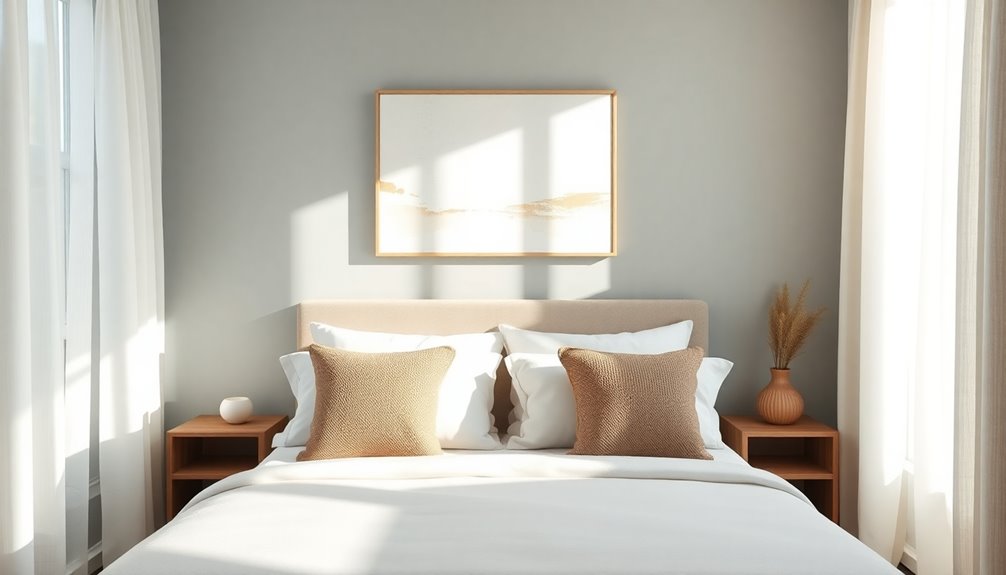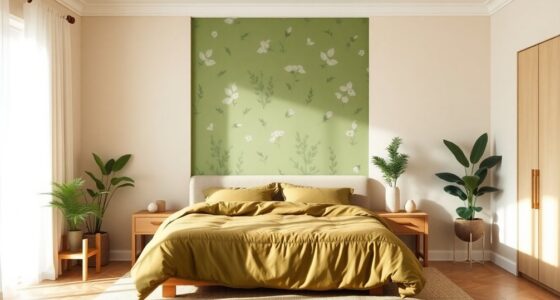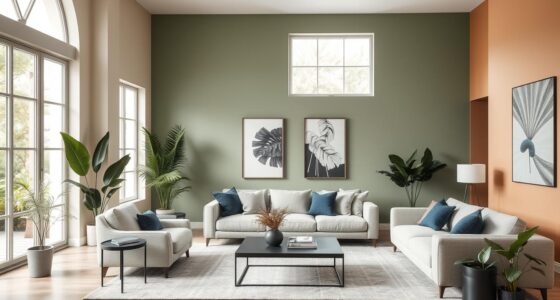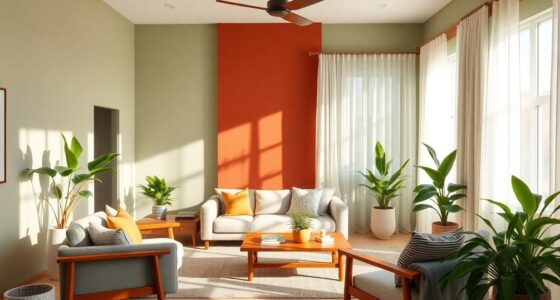Choosing the best paint colors for your master bedroom can create a peaceful retreat. Soft warm tones, like light pinks, add coziness, while soothing blues promote tranquility and better sleep. Earthy greens and calming neutrals enhance relaxation and spaciousness. For smaller bedrooms, lighter shades can expand the visual space. Testing different colors in your room's lighting will help you make the right choice. Stick around to explore more tips and trends for your ideal bedroom color palette.
Key Takeaways
- Soft warm colors like light pinks and creamy whites create a cozy and inviting atmosphere for relaxation.
- Cool hues such as soft blues promote tranquility and improve sleep quality in the master bedroom.
- Neutral colors like off-whites and soft grays enhance spaciousness and calmness, making the room feel more open.
- Earthy tones, including sage green and terracotta, evoke a peaceful ambiance that fosters comfort.
- Testing colors under different lighting conditions is crucial for choosing the perfect shade for your space.
Choosing the Right Color for Your Master Bedroom

When you're choosing the right color for your master bedroom, it's essential to evaluate how different hues can shape the room's atmosphere. Your personal preference will guide you, as soft warm colors like light pinks and creamy whites create a cozy, inviting atmosphere perfect for relaxation.
Neutral bedroom colors, such as off-whites and soft grays, offer calming colors that enhance spaciousness while complementing various decor styles. If you prefer a more dramatic effect, consider deep, richly saturated colors like navy or charcoal, which promote intimacy.
Don't hesitate to consult a color expert for personalized guidance, helping you visualize how different shades will look in your master bedroom under varying lighting conditions. Additionally, incorporating natural materials can enhance the overall warmth and comfort of your space.
Popular Color Trends for Bedrooms
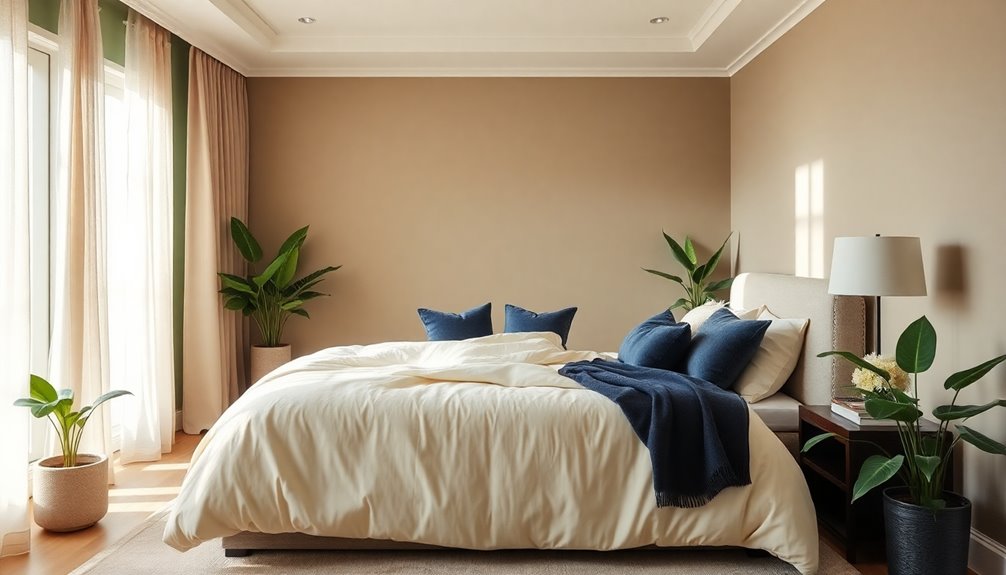
When you're choosing a color for your bedroom, consider trending palettes that include soft neutrals, calming blues, and earthy greens.
These hues not only enhance the mood but also create a serene space perfect for relaxation.
You might also find that two-tone combinations can add a unique touch while maintaining a cozy atmosphere.
Trending Color Palettes
Color plays an essential role in transforming your master bedroom into a serene retreat. Trending color palettes emphasize soft grays and warm whites, like Benjamin Moore's White Dove, to create a calming effect.
Soothing blues, such as Sherwin-Williams' Sea Salt, enhance tranquility while maximizing natural light. Consider incorporating sage green and earthy tones like terracotta to evoke a peaceful atmosphere.
Layering different shades of gray paint colors in various sheens adds depth and subtle contrasts to your bedroom color scheme. Two-tone combinations are also gaining popularity, pairing lighter colors with deeper accents for a visually interesting effect.
Mood-Enhancing Hues
Creating a calming atmosphere in your master bedroom often starts with the right mood-enhancing hues. Soft tones like warm colors, soothing blues, and pastel shades can transform your space into a serene retreat.
These calming colors foster relaxation and restful sleep, making them ideal choices for your bedroom. Neutrals, such as off-whites and soft grays, create tranquil backdrops that harmonize beautifully with various decor styles.
If you want to add a playful touch, consider incorporating soft pinks or light greens, which maintain an overall calming effect.
The Impact of Color on Mood and Relaxation
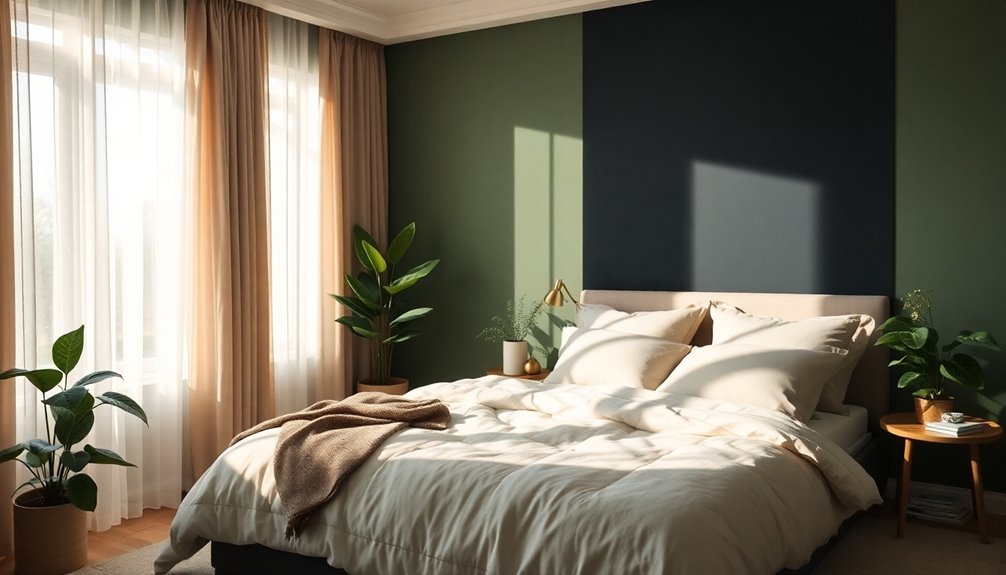
The colors you choose for your master bedroom can greatly affect your mood and relaxation.
Warm tones like soft pinks create a cozy atmosphere, while cool hues like blues promote tranquility and better sleep.
Color Psychology in Bedrooms
Choosing the right paint colors for your master bedroom can greatly impact your mood and relaxation. Soft, warm colors like light pinks and gentle creams create cozy, intimate environments, perfect for winding down.
Alternatively, cool hues such as soft blues and greens promote a calm, invigorating atmosphere that helps reduce stress and anxiety. Neutral colors, including off-whites and soft grays, establish tranquil environments that encourage peace and mindfulness.
By understanding color psychology, you can select shades that positively influence your mood, leading to improved sleep quality and a restorative space. Additionally, incorporating aromatherapy with essential oils can enhance the overall ambiance of your bedroom, further promoting relaxation.
Whether you prefer serene pastels or soothing neutrals, the colors you choose play a vital role in crafting a relaxing bedroom sanctuary.
Warm vs. Cool Tones
While selecting paint colors for your master bedroom, it's essential to reflect on how warm and cool tones influence your mood and relaxation.
Warm tones, like soft pinks and earthy neutrals, foster a cozy atmosphere that promotes comfort and intimacy in your relaxing bedroom. On the other hand, cool hues such as calming blue and soft greens create a rejuvenating environment that encourages tranquility and restful sleep.
The right balance can enhance the overall ambiance, making your space inviting. Remember, deeply saturated colors can energize a room, while neutrals help establish a tranquil backdrop ideal for relaxation.
Ultimately, your color choices greatly impact your mood, so choose wisely for a peaceful retreat.
Choosing Relaxing Color Schemes
Color schemes play an important role in shaping the atmosphere of your master bedroom, directly impacting your mood and relaxation levels.
To create cozy spaces, consider using soft greige and warm white; these hues foster intimacy and enhance overall relaxation. For a tranquil environment, calming blue and sage green are excellent choices, promoting peace and reducing stress. Light pink can also add warmth while maintaining a soothing ambiance.
While deeply saturated colors might energize, they can also create a comforting cocoon-like effect. Balancing these colors with neutrals helps establish relaxing color schemes, ideal for restful sleep and a serene atmosphere. Additionally, using calming colors in your bedroom can improve your overall wellness and contribute to better sleep quality.
Ultimately, your color selections will greatly influence your emotional state, making careful choices essential for your retreat.
Calming Color Schemes for a Serene Space
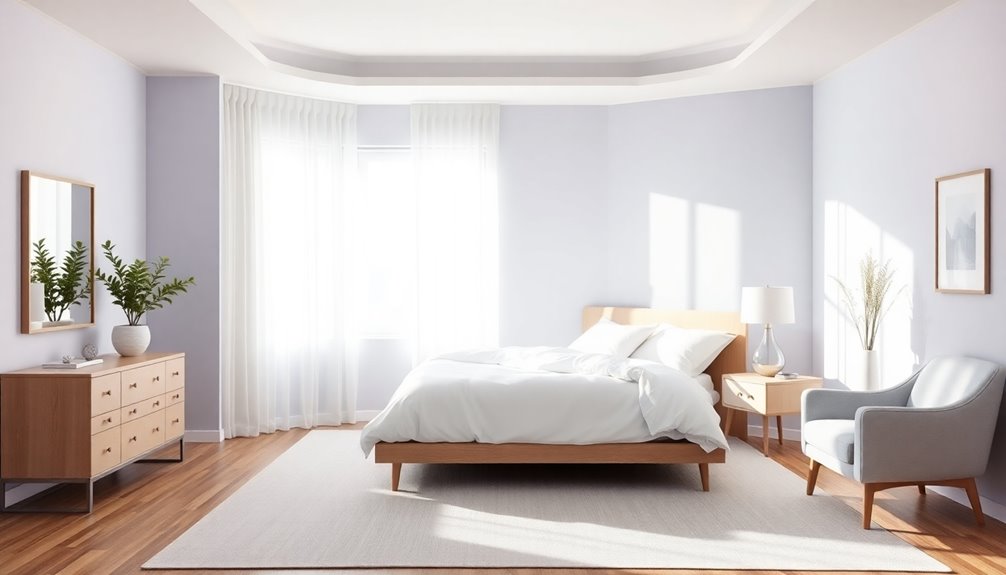
Creating a serene space in your master bedroom hinges on selecting calming color schemes that foster relaxation and tranquility.
Soft colors like light pinks and muted grays create cozy, intimate environments, perfect for unwinding after a long day. Cool hues, such as deep blues and sage greens, promote a calming atmosphere, reducing stress and enhancing sleep quality.
Neutral shades, including off-whites and soft beiges, establish a tranquil backdrop, making your space feel more inviting and spacious. Incorporating pastel colors, like pale blues and greens, mimics nature's soothing effects, further enhancing serenity.
Additionally, layering shades of the same color, such as grays or greens, adds depth and sophistication while maintaining a soothing ambiance that encourages restful nights.
Modern Paint Color Combinations
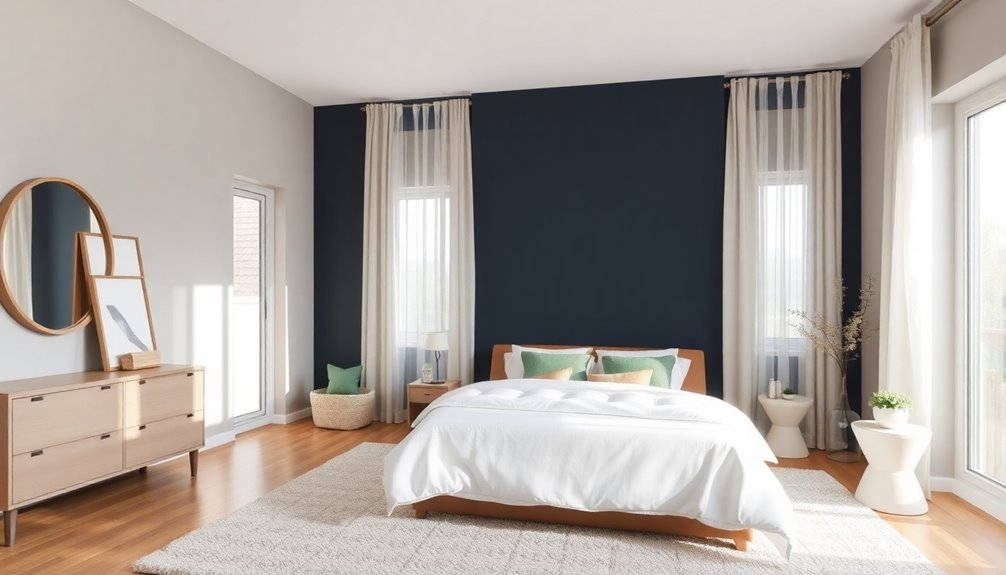
Modern paint color combinations can transform your master bedroom into a stylish retreat. Think about using warm gray shades paired with soft blues or a serene green shade. These colors create a calming atmosphere that complements natural light beautifully.
You can enhance the look by incorporating white trim, providing a crisp contrast against the muted hues. Consider a two-tone bedroom combination, like light gray walls with deeper accent walls, to add visual interest while keeping a cohesive feel.
Layered grays and different sheens of the same color can introduce subtle contrasts, perfect for modern interiors focusing on clean lines. With these combinations, your bedroom becomes a sophisticated and inviting space you'll love to unwind in.
Inspired by Nature: Earthy Tones
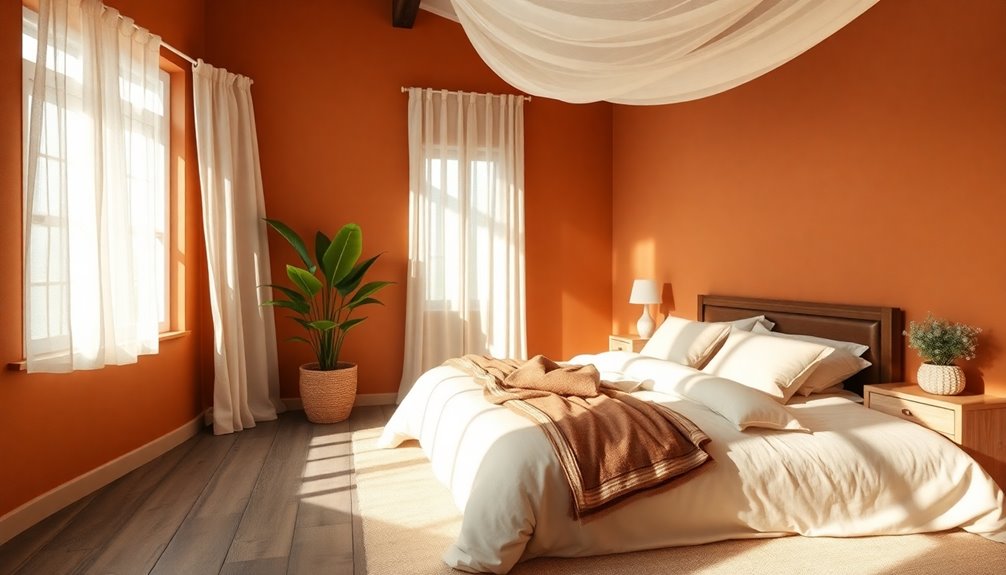
When you want to bring a slice of the outdoors into your master bedroom, earthy tones offer a perfect solution. Soft greens, like Quietude and Rocky River, create a serene atmosphere, promoting tranquility and comfort. Shades like Stirabout enhance relaxation while providing a cohesive look throughout the room. Olive-gray tones, such as Gray Heron, serve as a peaceful backdrop, harmonizing beautifully with natural elements like reclaimed wood. For a cozy sanctuary, deep colors like Mystere blend plum and clay-brown, reminiscent of lush landscapes.
| Color Name | Description |
|---|---|
| Quietude | Soft sage green for tranquility |
| Stirabout | Earthy neutral with a hint of gray |
| Rocky River | Rich green for comfort |
| Gray Heron | Olive-gray for a peaceful backdrop |
| Mystere | Deep plum and clay-brown blend |
Light and Airy Colors for Small Bedrooms
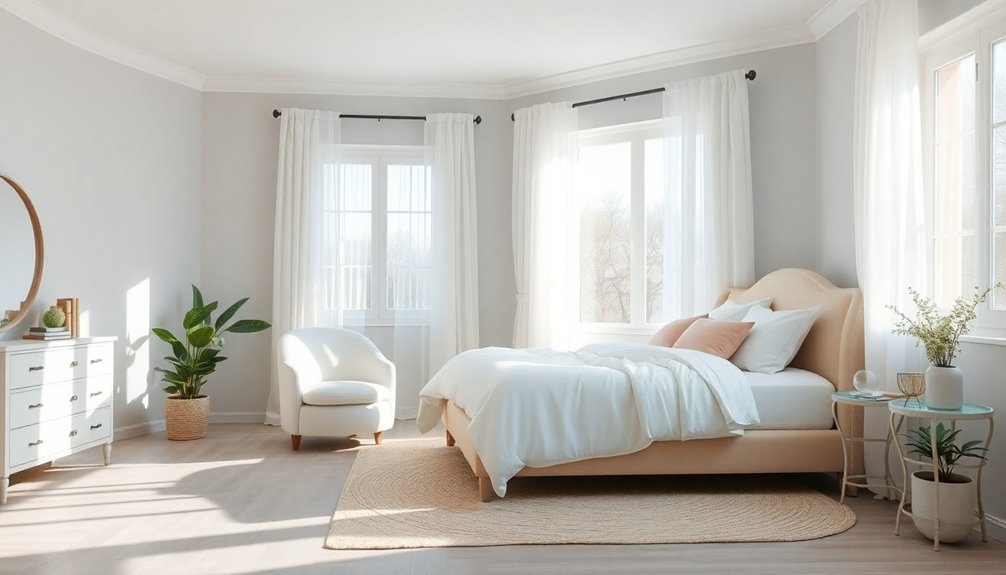
Bringing in a sense of space and light is key for small bedrooms, and light, airy colors are the perfect way to achieve that.
Soft whites and pale pastels expand the visual space, making your room feel larger and more inviting. Consider using Benjamin Moore's First Light for a calming pink hue that enhances warmth and brightness.
Alternatively, Sherwin-Williams' Origami White provides a smooth, creamy backdrop that complements various decor styles without feeling stark.
Light blue-gray tones, like Sherwin-Williams' Upward, promote tranquility and visually expand your space—especially when paired with crisp white accents.
Don't forget to use lighter shades on the ceiling to enhance height perception, further contributing to a spacious atmosphere in your small bedroom.
Expert Tips for Selecting Your Perfect Shade
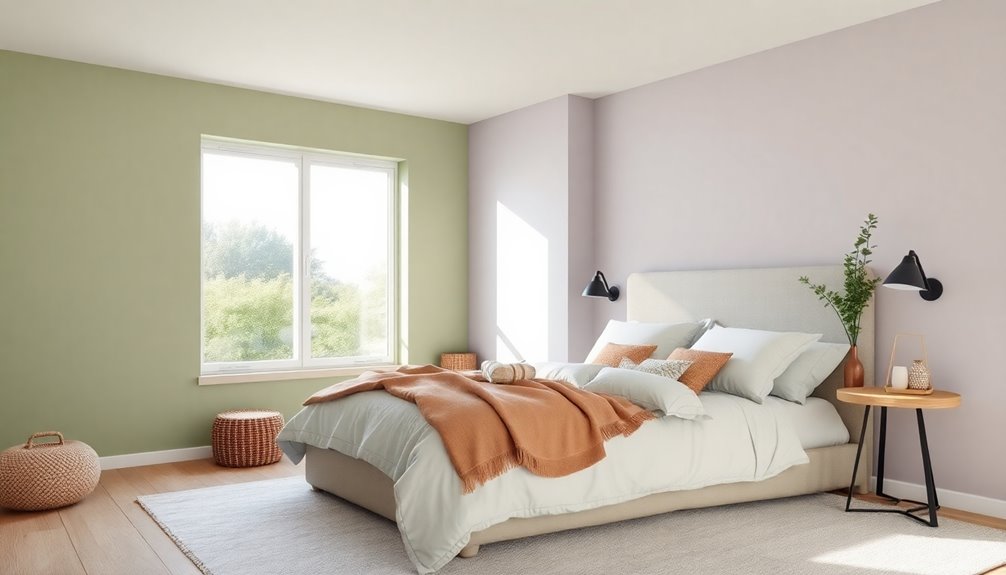
How can you guarantee that the paint color you choose for your master bedroom perfectly aligns with your vision? Start by considering the mood you want to create; warm colors foster coziness, while cool hues promote calmness.
Explore popular paint colors like soft grays, blues, and earth tones, known for their tranquil effects and versatility in design style.
Pay attention to your room's lighting, as natural light can change how a shade appears throughout the day. Use color samples and swatches to visualize different colors in your space.
Finally, don't hesitate to seek expert tips, including virtual consultations with color professionals, to tailor your selection to your personal preferences and enhance your bedroom's ambiance. Additionally, consider incorporating sustainable materials in your decor for a stylish and eco-friendly approach.
Frequently Asked Questions
What Is the Best Color for a Master Bedroom?
When you think about the best color for your master bedroom, consider what makes you feel relaxed.
Soft, warm tones like light pinks or gentle grays can create a cozy atmosphere.
Alternatively, calming blues and muted greens help enhance tranquility and improve sleep quality.
If you prefer a more sophisticated vibe, rich browns or deep charcoals can envelop the space in warmth.
Ultimately, choose a color that resonates with you and makes you feel at home.
What Are the Top 3 Bedroom Colors?
Imagine stepping into a serene oasis every day.
The top three bedroom colors that help create this haven are soft blues, warm beiges, and rich grays.
Soft blues wrap you in tranquility, while warm beiges invite a cozy embrace.
Rich grays can energize the space, adding depth and comfort.
Each color transforms your room into a sanctuary, allowing you to unwind and recharge, making your bedroom truly a retreat from the world.
What Is the Most Relaxing Color to Paint a Bedroom?
When you're looking for the most relaxing color to paint your bedroom, consider soft blues or gentle greens.
These cool hues not only create a calming atmosphere but also evoke a sense of tranquility, making it easier for you to unwind.
If you prefer neutrals, soft grays or creamy whites can also foster a peaceful environment.
Ultimately, choose shades that resonate with you and promote a sense of comfort and serenity in your space.
What Is the Most Positive Color for a Bedroom?
Choosing the most positive color for your bedroom is like selecting a mood-lifting playlist; it can transform your space instantly.
Bright, warm colors like sunny yellows and cheerful corals can infuse energy and happiness into the atmosphere. These shades not only brighten the room but also boost your spirits.
Consider how each color resonates with you personally, as the right choice will create a welcoming environment that fosters relaxation and joy in your daily life.
Conclusion
In the end, choosing the perfect paint color for your master bedroom can transform your space into a personal sanctuary. Whether you lean towards calming blues or earthy greens, remember that the right hue can be like a warm embrace, wrapping you in comfort. Don't rush the process—explore different shades, and let your instincts guide you. Your bedroom isn't just a place to sleep; it's a canvas for your dreams. Happy painting!
